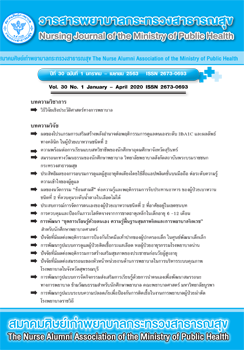A Development of Caring Model for Sepsis Patients in the Medical Wards, Nan Hospital
Main Article Content
Abstract
This research and development study aimed to develop and evaluate a caring model for sepsis patients in the medical ward of Nan Hospital. The research was divided into 3 phases. Phase 1: Situational analysis included 1) in-depth interviews of 20 members of the multidisciplinary health care team in the medical wards and 2) focus group discussions among nine members who developed the caring model. Phase 2: Developing and implementing the Caring Model included the development of the model by conducting two focus group discussions among 8 health care members who would use the model for their opinions regarding the model and implementation of the model in the medical ward for 3 months. Phase 3: Model Evaluation was carried out by comparing clinical results before and after using the model. The quantitative data were analyzed using percentage, mean, Chi-Square tests, and the Mann-Whitney U Test while content analysis was performed for qualitative data analysis. The results showed that in Phase1, factors affecting the care for sepsis patients included the duration of the diagnosis and treatment of sepsis, dissemination of caring guidelines to personnel at all levels, communication among multidisciplinary teams, and monitoring and supervising the multidisciplinary team to follow the guidelines. Phase 2: the caring model for sepsis patients comprised 1) early screening and prompt treatment for high-risk patients, 2) workforce management using skill mixed nursing care team, 3) providing a workshop to enhance update knowledge for the multidisciplinary team, 4) creating a manual for nursing practice, and, 5) establishing a system for monitoring and supervising the multidisciplinary care team. Phase 3: after implementation of the 3-month study, it was found that the number of patients who received early diagnosis and prompt treatment of sepsis was significantly increased (χ2=13.017, p<.05). The number of patients who suffered from septic shock and mortality rate statistically significant decreased (χ2=10.80, χ2=1.92, p<.05)
Article Details
บทความและรายงานวิจัยในวารสารพยาบาลกระทรวงสาธารณสุข เป็นความคิดเห็นของ ผู้เขียน มิใช่ของคณะผู้จัดทำ และมิใช่ความรับผิดชอบของสมาคมศิษย์เก่าพยาบาลกระทรวงสาธารณสุข ซึ่งสามารถนำไปอ้างอิงได้
References
2. Martin GS, Mannino DM, Eaton S, Moss M. The epidemiology of sepsis in the United States from 1979 through 2000. N Eng J Med 2003;348(16):1546-54.
3. Ministry of Public Health 2018. The report of Mortality rate in patients with sepsis [internet].2019 [cited 2019 Febuary11]. Available: http://hdcservice.moph.go.th/hdc/reports
4. Castle SC, Norman DC, Yeh M, Miller D, Yoshikawa TT. Fever response in elderly nursing home residents are the older truly colder? J Am Geriatr Soc 1991;39:853-57.
5. Girard TD, Opal SM, Eyl EW. Insights into severe sepsis in older patients: from epidemiology to evidence based management. Clin Infect Dis 2005;40:719-27.
6. Opal SM, Girard TD, Eyl EW. The immunopathogenesis of sepsis in elderly patients Clin Infect Dis 2005;41(7):504-12.
7. American College of Chest Physician (ACCP)/Society of Critical Care Medicine Consensus Conference: definitions for sepsis and organ failure and guidelines for the use of innovate therapies in sepsis. Crit Care Med 1992;20:864-74
8. Deming, Edward W. Out of the crisis. USA: The Massachusetts Institute of Technology Center for Advanced Engineering Study. 1995.
9. Medical record and statistics of Nan Hospital 2016. Unpublished paper.
10. Pipatwate K. Predisposing factors of mortality in septic patients in Uttaradit Hospital. Thai journal of tuberculosis chest diseases and critical care,2551;29(1):135-44.(in Thai).
11. Mahantassanapong C. Outcome of the Surin sepsis treatment protocol in sepsis management Srinagarind Medical Journal 2555;27(4):332-39.(in Thai).
12. Nueng Nasuwan W, Normkusol J, Tongjam R, Panapat T. Development of the nursing service system for patients with severe sepsis. Journal of Nursing and Health 2014;32(2):25-36.(in Thai).
13. Komal P, Namjantra R, Binhosen W. Quality of care management in persons with sepsis syndrome at emergency department in Singburi Hospital. Journal of Business Administration 2017;6(2):32-43. (in Thai).
14. Butsara W, Linglom Y, Kummuek S. Developing a system of care for patients with sepsis. Journal of Humanities and Social Sciences Nakhon Phanom University;2560:17-25.(in Thai).
15. Treebupachatsakul P, Kamsawang N, Tuandeang P. Clinical outcome after application of CPG for sepsis. Buddhachinaraj Medical Journal 2009;24(1):33-45. (in Thai).
16. Thiemsuwan Y, Malahom O, Uindesuk T, Kwanchang P, Prasertsri N. The development caring system of critical sepsis patients by case management at Sunprasithtiprasong Hospital, Ubon Ratchathani Journal of Nursing and Health Care 2017;35(1):184-93.(in Thai).
17. Punvittayakool J, Maneeprai J. The development of care model for sepsis. Journal of Nursing Division.2561;45(1):86-104.(in Thai).
18. Onswadipong P, Sungkard K, Kusuma Na Ayuthya S, Rongrungruan Y. The effect of early goal-directed nursing intervention on severity of organ failure in patients with sepsis syndrome. Journal of Nursing Science 2010;29(2):102–10.(in Thai).
19. Jiragangwan M. Development of nursing model for severe sepsis in Sisaket Hospital. Journal of Nursing Divition 2015;42(3):9-32.(in Thai).
20. Suranatchayanan P, Kenthongdee W, Kamonrat S. Nursing care system development for sepsis patients at Loei Hospital. Journal of Nursing and Health Care 2018;36(1):207-15.(in Thai).
21. Joint Commission Resources. Joint commission international accreditation standards for hospitals, 6th ed. Oak Brook, IL, USA: 2017.
22. Chairatana P, Tudsapornpitakkul S. The effectiveness of nursing care model for sepsis patients. Journal of Nursing and Health 2017;35(3):224-31.(in Thai).

